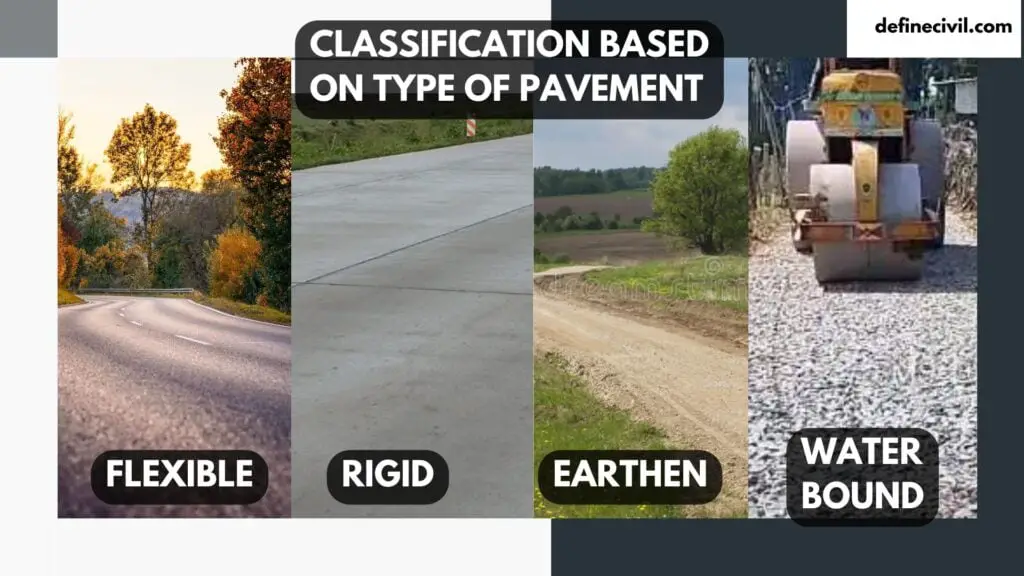Did you notice, is that an arterial road or a motorway? Well, with so many different types of roads depending on number of factors; it is important to know the features and differences between all.
We classify the roads on number of factors; but in most of the cases we have following types of roads on the basis of material:
- Concrete roads.
- Asphalt roads.
- Gravel roads.
- Earthen roads.
- Murrum roads.
- Kankar roads.
- Bituminous roads.
Anyhow, in our today’s article I’ve explained in detail all the different classification of roads on different basis.
So, let’s delve in:
Road Types
Road is defined as, ‘an artificial passage way for vehicles used for the purpose of transportation’. Roads have been in use since the beginning of civilization for the movement of goods, people, from one destination to another.
With technological advancements, the design of roads has improved over time. From mud roads to paved roads, there are multiple types of roads that have been used over time. In this article, we will discuss different types of roads according to different criterion.
Also Read: Asphalt concrete – Types – Mix Design – Price – PDF

Types of Roads
Roads are primarily classified based on below mentioned aspects.
- Accessibility and mobility
- Type of pavement (Rigid or Flexible)
- Construction material used
- Economical aspects
- Traffic volume
- Traffic type
- Topography
- Location and Function
Now among these factors, we will discuss important aspects that primarily distinguish various types of roads.
Classification Based on Accessibility and Mobility
Based on accessibility and mobility roads are classifies into following types.
Freeway or Motorway or Controlled Access Highway
A controlled access highway is so called because it offers access to limited types of vehicles. It is designed for fast moving vehicles and provides comparatively shorter route and lesser travel time from one destination to another.
It does not have any signals, footpaths, parking spaces, etc. Thus, it provides undisturbed traffic flow. It has controlled access points at the start and exit point through which only allowed types of vehicles can access it.
Motorways are provided with grade separated intersections. Whenever a motorway meets another road or railway, the grades at intersection points are separated and intersecting road or railway is carried above or below the motorway.
This provides unhindered traffic movement and obviates the need of traffic control setups like signals.

Highway
A highway offers flexibility in terms of access. It does not have any restriction on the types of vehicles accessing it. A highway is provided with traffic signals depending on the need. Highways are provided with at grade intersections.
Whenever another road or railway meets a highway, both intersect at same grade. Thus, highways do not provide completely undisturbed flow as is the case with motorways.

Arterial Roads
Arterials are city roads which are meant for thorough traffic, usually on a continuous route. These are the primary roads at city level. In terms of traffic capacity, arterials are high capacity roads. But, in road hierarchy vis-à-vis traffic capacity arterials lie below freeways and highways.
Arterials handle majority of traffic volume of a city at higher level of mobility and provide movement within the city. Also, arterial roads connect a city’s traffic to freeways or highways. Arterials are provided with signals, roundabouts, footpaths, and pedestrian crossings.

Sub-arterial Roads
These also are city roads which provide lower level of traffic mobility than arterial roads. In hierarchy of urban roads, sub-arterial roads sit below arterial roads in terms of travel mobility. These are connected to arterial roads.
Collector Roads
Collector roads are secondary roads in the hierarchy of urban roads. Collector roads are connected to sub-arterial roads. These are constructed for collection and distribution of traffic to and from local streets.
Collector roads are located in residential, industrial, and commercial areas. Generally, there are no parking restrictions on collector roads.
Local Roads
Local roads are tertiary roads in the hierarchy of urban roads. Local roads are connected to collector roads. These provide access to residential, industrial, and commercial areas. A local road maybe a residential road, industrial road, or commercial road.
Classification Based on Type of Pavement
In terms of type of pavement, roads are mainly classified into two categories; flexible pavement and rigid pavement.
Flexible Pavement
Flexible pavement has a wearing course constructed of asphalt concrete placed on a good quality and compacted granular material. It is called flexible because of its resilience; it deflects under the influence of load and reverts back to its original state to some extent after some time. Flexible pavements possess low flexural strength.
Also Read: Difference between Flexible and rigid Pavement (Fully EXPLAINED)
The layers provided in a flexible pavement our subgrade, sub-base, base course, and a bituminous concrete wearing course at the top. Loads are transferred from grain to grain to lower layers.
Temperature variations have little effect on flexible pavements because of their self-healing property and flexibility. The overall strength of a flexible pavement depends on the strength of subgrade below.

Rigid Pavement
A pavement which has surface made of PCC (Plain Cement Concrete) or RCC (Reinforced Cement Concrete) is called a rigid pavement. It is called rigid pavement because it possesses high flexural strength, rigidity, modulus of elasticity, and does not deform under loads. The strength of a rigid pavement mainly depends on the strength of concrete. Loads are not transferred by layer to layer action as is the case in flexible pavement.
Also Read: Rigid Pavement – Types – Stresses – Design
Loads are transferred by beam action and high flexural strength and rigidity transfer loads over a wide area of subgrade. Furthermore, minor variations in subgrade strength does not affect the structural behavior of a rigid pavement.
The rigid pavement can accommodate localized deformations in the subgrade because of slab action of pavement. Temperature variations affect rigid pavements and are likely to cause cracks. To cater this, contraction joints and expansion joints are provided in rigid pavements. Rigid pavements do not have self-healing properties; any deformation caused is permanent.
Classification Based on Construction Material
Types of roads according to material used are listed below.
Earthen Roads
Earthen roads are constructed using ordinary soil. The soling or foundation of earthen roads and pavement consists of same ordinary soil. The soil is placed in layers and is compacted thoroughly.
Water is applied during compaction to increase bonding between soil particles. Earthen roads are used as temporary roads and these are mostly used in rural areas.
Gravel Roads
Gravel roads are unpaved roads and have compacted gravel as pavement. Gravel is used in combination with some binding material such as ordinary soil. This binding material helps in better compaction. Compaction is done by rollers.
Gravel roads are simple to construct and are cheaper variety of roads. These are mostly used in rural areas.
Also Read: Water Bound Macadam Road – WBM – Base Course – Specification – Procedure
Water Bound Macadam Road (WBM)
A water bound macadam road is a road in which the wearing course consists of clean crushed aggregate which is mechanically interlocked by rolling action.
Filler material and binding material is used in conjunction with coarse aggregate and these help in bonding the aggregate together and fill the pores between aggregate. Water bound macadam roads fall under the category of semi-rigid pavement.
Also Read: Curbs and Gutter – Detail – Types – Dimensions – Advantages
Murram Roads
Murram is a clayey material and it is essentially decomposed laterite. It is widely used for road surfacing. Road which consists of surface made up of well compacted murram is called murram road. Murram road gives better finish than earthen and gravel roads.
Kankar Roads
Kankar is basically impure form of limestone. Roads constructed using kankar as surface material are called kankar roads. These are recommended in areas which have abundant quantity of limestone. Kankar roads are low quality roads. However, it is better than earthen roads and gravel roads.
Bituminous Roads
Bituminous roads are the most commonly used roads worldwide. Bitumen is a sticky, black, highly viscous mixture of hydrocarbons obtained naturally or as a residue from distillation process of petroleum. It may exist in liquid phase or semi-solid phase. In bituminous roads, bitumen is used as a binding material with coarse aggregate.
The resultant mixture formed by mixing bitumen/asphalt and aggregate is called asphalt concrete. It is used in flexible pavements. Asphalt concrete forms the top layer in flexible pavement roads. Layers of bituminous concrete roads consist of a subgrade, sub-base, base course, and wearing course.
Subgrade is the natural soil that is compacted to desired density. Sub-base and base course consist of standard size and well-graded aggregate and filler material. The top layer consists of wearing course which is made of asphalt concrete.
Concrete Roads
Concrete roads are also most commonly used roads worldwide. Concrete is a heterogeneous mixture of cement, sand, coarse aggregate, and water. Concrete roads maybe made of PCC or RCC. These are typically used for heavy traffic and where traffic loads are high. The overall cost of constructing concrete roads is higher than bituminous roads.
However, concrete roads do not require heavy maintenance which is not the case with bituminous roads. As discussed earlier, concrete roads are rigid pavement roads.
Also Read: Weight of concrete – Density – Concrete Slab – Driveways
Classification Based on Topography
In terms of topography, roads are primarily classified as those constructed in plain areas and those constructed in hilly areas.
Roads in Plain Areas
Roads which are constructed on flat land are fall under the category of roads in plain areas. These roads do not have abrupt changes in gradient and sharp turns. Also, there are no hair pin bends and steep slopes are occasionally encountered.
Roads in Hilly Areas
Roads which are constructed in hilly areas fall under this category. These roads have higher frequency of steep gradients and sharp turns. Also, hair pin bends are seen in these roads.

Classification Based on Traffic Volume
In terms of traffic volume, roads are classified as low volume roads, medium traffic roads, and high traffic roads.
Low Volume Roads
Low volume roads are those which lie outside the built-up areas of cities, commercial areas, and towns. These roads have a traffic volume of less than 400 AADT (Annual Average Daily Traffic). These roads are usually located in rural areas and connect rural communities.
Medium Volume Roads
Roads which have traffic volume between 400 and 1000 AADT are termed as medium volume roads.
High Volume Roads
Roads which have traffic volume greater than 1000 AADT are called high volume roads.
Classification Based on Location and Function
In terms of location and function, roads are divided into following categories.
National Highways
National highways are of national importance. These highways connect every major city of a country and central capital. These also connect commercial and industrial centers with airports, sea ports, state capitals and important tourist centers. These highways are the key component of a country’s infrastructure.
State Highways
These highways connect district headquarters with state headquarters or highways of neighboring states.
District Roads
District roads traverse every district and serve areas of production and markets and connect these with each other or with National or State Highways.
Village Roads
The roads which connect a village to adjoining village or group of villages with each other and to nearest district road, are called village roads.

















